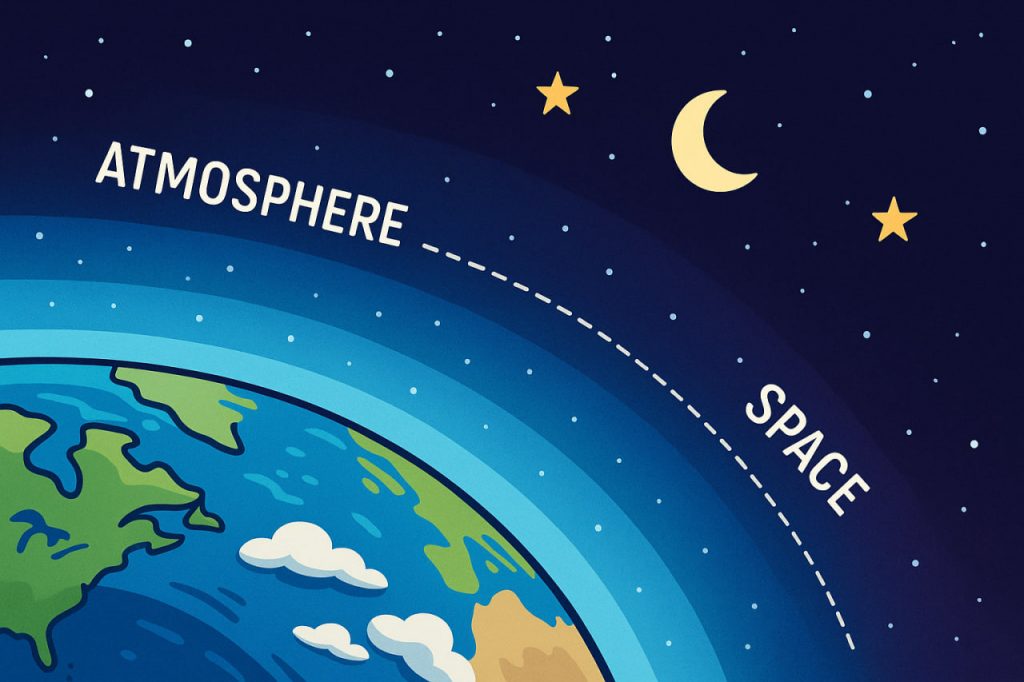When we look up at the sky, it may seem like space begins just beyond the clouds. But scientifically defining where Earth ends and space begins is far more complex. The boundary between the atmosphere and outer space doesn’t have a visible line — instead, it’s defined by altitude, atmospheric density, and practical use (such as satellite orbit). The most widely accepted boundary is known as the Kármán line, but it’s not the only interpretation. Let’s explore how scientists define the edge of space — and why it matters.
The Kármán Line: 100 Kilometers Up
The Kármán line, named after Hungarian-American engineer Theodore von Kármán, is the most commonly accepted boundary of space. It is set at an altitude of 100 kilometers (62 miles) above sea level. At this height:
- The atmosphere becomes extremely thin.
- Aerodynamic lift is no longer possible — meaning aircraft cannot rely on air pressure to stay aloft.
- Only orbital velocity can keep a vehicle in motion without falling back to Earth.
The Fédération Aéronautique Internationale (FAI) recognizes the Kármán line as the official start of outer space.
NASA and the U.S. Definition: 80 Kilometers
In contrast, NASA and the U.S. military consider the boundary of space to begin at 80 kilometers (50 miles) above Earth’s surface. According to this definition, pilots or astronauts who cross that line are awarded astronaut wings.
This variation highlights that the boundary is more of a legal and practical convention than a fixed physical feature.
Atmospheric Layers Leading to Space
Earth’s atmosphere doesn’t end abruptly — it gradually becomes thinner with altitude. The layers include:
- Troposphere (0–12 km): Weather occurs here.
- Stratosphere (12–50 km): Contains the ozone layer.
- Mesosphere (50–85 km): Meteors often burn up here.
- Thermosphere (85–600 km): Hosts auroras and the ISS orbit.
- Exosphere (600+ km): Fades into the vacuum of space.
Technically, even the International Space Station, orbiting at about 400 km, is still within the thermosphere, which contains traces of atmospheric particles.
Why the Definition Matters
Knowing where space begins is important for several reasons:
- Legal boundaries: International space law requires clear definitions of airspace vs. outer space.
- Military and commercial regulations: Airspace is governed by nations; space is considered global commons.
- Scientific classification: Instruments, satellites, and missions are labeled based on altitude and orbital environment.
For companies launching satellites or astronauts, understanding these limits affects licensing, responsibility, and insurance.
The Experience of Space Begins Gradually
Even before reaching the Kármán line, travelers experience:
- Reduced gravity (microgravity begins around 80 km).
- Black sky due to thin atmosphere.
- Curvature of Earth visible from 30–40 km.
- Silence, as air becomes too thin to carry sound.
That’s why high-altitude balloons and suborbital flights can provide a taste of space without crossing into orbit.
Glossary
- Kármán line: An internationally recognized boundary of space at 100 km altitude.
- Atmosphere: The layers of gases surrounding Earth.
- Thermosphere: A high layer of atmosphere containing satellites and auroras.
- Exosphere: The outermost atmospheric layer, merging into space.
- Orbital velocity: The speed needed to stay in orbit around a body without falling back.
- Astronaut wings: Honors awarded to those who cross into space (varies by definition).


